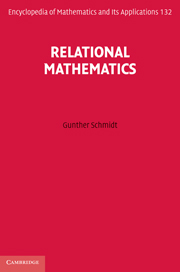Book contents
- Frontmatter
- Contents
- Notes on illustrations
- Preface
- 1 Introduction
- PART I REPRESENTATIONS OF RELATIONS
- PART II OPERATIONS AND CONSTRUCTIONS
- 4 Algebraic operations on relations
- 5 Order and function: the standard view
- 6 Relations and vectors
- 7 Domain construction
- PART III ALGEBRA
- PART IV APPLICATIONS
- PART V ADVANCED TOPICS
- Appendix A Notation
- Appendix B Proofs postponed from Part II
- Appendix C Algebraic visualization
- Appendix D Historical annotations
- References
- Symbols
- Index
7 - Domain construction
from PART II - OPERATIONS AND CONSTRUCTIONS
Published online by Cambridge University Press: 05 May 2013
- Frontmatter
- Contents
- Notes on illustrations
- Preface
- 1 Introduction
- PART I REPRESENTATIONS OF RELATIONS
- PART II OPERATIONS AND CONSTRUCTIONS
- 4 Algebraic operations on relations
- 5 Order and function: the standard view
- 6 Relations and vectors
- 7 Domain construction
- PART III ALGEBRA
- PART IV APPLICATIONS
- PART V ADVANCED TOPICS
- Appendix A Notation
- Appendix B Proofs postponed from Part II
- Appendix C Algebraic visualization
- Appendix D Historical annotations
- References
- Symbols
- Index
Summary
It has been shown in Chapters 2 and 3 how moderately sized sets (termed basesets when we want to stress that they are linearly ordered, non-empty, and finite), elements, vectors, and relations can be represented. There is a tendency to try to extend these techniques indiscriminately to all finite situations. We do not follow this trend. Instead, sets, elements, vectors, or relations – beyond those related to ground sets – will carefully be constructed, in particular if they are ‘larger’. Only a few generic techniques are necessary. They are presented here in detail as appropriate.
These techniques are far from being new. We have routinely applied them in an informal way since our school days. What is new in the approach chosen here is that we begin to take these techniques seriously: pair forming, if–then–else–fi–handling of variants, quotient forming, etc. For pairs, we routinely look for the first and second components; when a set is considered modulo an equivalence, we work with the corresponding equivalence classes and obey carefully the rule that our results should not depend on the specific representative chosen, etc.
What has been indicated here, however, requires a more detailed language to be expressed. This in turn means that a distinction between language and interpretation is suddenly important, which one would like to abstract from when handling relations ‘directly’. It turns out that only one or two generically defined relations are necessary for each construction step with quite simple and intuitive algebraic properties.
- Type
- Chapter
- Information
- Relational Mathematics , pp. 106 - 154Publisher: Cambridge University PressPrint publication year: 2010

